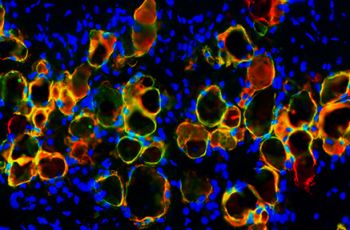WASHINGTON (Oct. 21, 2014) — With an estimated three percent of compounds assessed ever being used in patients, those affected by myasthenia gravis — a debilitating autoimmune disorder — are desperate for a drug development breakthrough. George Washington University (GW) expert Linda Kusner, Ph.D. is seeking to tackle this high failure rate through looking at deficiencies in “pre-clinical” assessment of therapies.
On Sept. 24-25, Kusner organized a meeting of myasthenia gravis experts from across the globe at the National Institute of Neurological Disorders and Stroke (NINDS), with support from the NINDS, Myasthenia Gravis Foundation of America, and the GW School of Medicine and Health Sciences (SMHS). Discussed was an important tenet of raising the rate of drug development success: Higher research standards.
“The conference is a pivotal moment in myasthenia gravis research,” said Henry Kaminski, M.D., chair of the Department of Neurology at SMHS, who participated in the conference. “We no longer want to simply use medications developed for other diseases and adapt for myasthenia gravis patients. This conference focused specifically on drug development for myasthenia gravis.”
Myasthenia gravis compromises nerve communication with the muscle. Because it is a rare disease and has a smaller pool of potential trial participants, having the highest standards for research is essential.
“Rigorous and consistent study design, execution, analysis and interpretation of animal or cell-based studies are required to optimize moving a molecule to a safe, effective drug for human use,” said Kusner, assistant research professor of pharmacology and physiology at SMHS.
The two-day workshop, “Standards for Preclinical Efficacy Evaluations for Myasthenia Gravis,” revolved around discussion and development of consensus guidelines regarding experimental methods, outcome assessments, and statistical requirement in a manner that ensures comparability and reproducibility by investigators across the world. Variability in phenotype of laboratory animals, which is influenced by housing conditions, litter size, food composition, temperature and many other factors, were identified as important variables to control.
“The risk of discarding a useful therapy or taking an agent to human assessment that is then demonstrated to be ineffective or toxic needs to be minimized,” said Kaminski. “Of course, discarding a potentially useful treatment should not be stopped by poor pre-clinical assessment.”
Reports from the conference will be published later this year in a special issue of Experimental Neurology. Participants are already planning a follow-up meeting as part of the “Myasthenia Gravis & Related Disorders” conference held by the Society of British Neurologists in the United Kingdom in Jan. 2016. Kaminski and Kusner are assisting in organizing this event.


